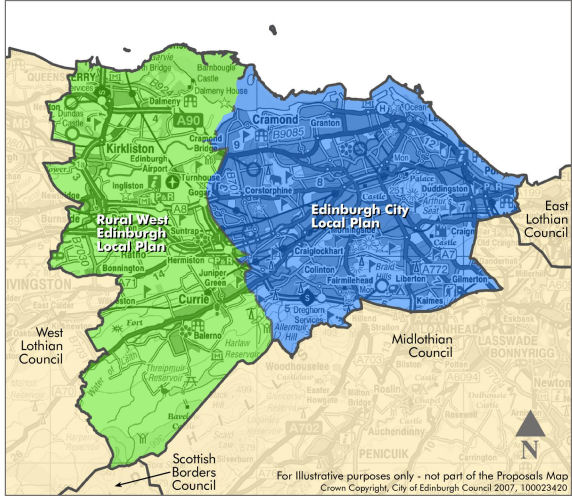Chapter 1: Introduction

The Edinburgh City Local Plan
1.1 The Edinburgh City Local Plan sets out the Council's policies to guide development in the city and its proposals for specific sites. The Plan covers the whole of the urban area, and part of its rural, Green Belt fringe. A second local plan, the Rural West Edinburgh Local Plan, covers the remainder of the Council's area, generally west of the City Bypass. Figure 1.1 shows how the Council's area is divided between these two plans. The Edinburgh City Local Plan is a replacement for five existing local plans, prepared at various times since 1992, covering different parts of the same area.
1.2 The Local Plan has been prepared within the wider, strategic framework set by the Edinburgh and the Lothians Structure Plan 2015 for the City of Edinburgh Council area and that of the three Lothian councils. This was approved by the Scottish Ministers in 2004. The Local Plan has the same end date in view, i.e. 2015.
1.3 The purpose of the Local Plan is to:
- provide a clear basis for determining planning applications
- allocate land to meet needs and targets set out in the Structure Plan
- provide a clear framework for regeneration strategies prepared by the Council, other public sector agencies and developers
- provide support for wider strategies of the Council, particularly the Local Transport Strategy, and help infrastructure providers to plan for the future.
1.4 The Local Plan and the Structure Plan together make up the development plan for the area that they both cover. Planning legislation states that decisions on planning applications and other planning matters should: 'be made in accordance with the development plan unless material considerations indicate otherwise' (Section 25 and 37(2) of the Town and Country Planning (Scotland) Act 1997).
Figure 1.1 Edinburgh Local Plan Boundaries

National Planning Policy Guidance
1.5 Local plans are expected to be consistent with national planning policy and advice issued by the Scottish Government. This identifies how the planning system can support the Executive's wider objectives for sustainable development, economic competitiveness, social justice, environmental quality, design and integrated transport. A range of national documents are of relevance to the Local Plan area, including Scottish Planning Policies (SPPs), Planning Advice Notes (PANs), Designing Places and Scottish Historic Environment Policy. The Local Plan has been prepared in line with the content of these documents.
National Planning Framework for Scotland
1.6 The Scottish Executive published the National Planning Framework for Scotland (NPF) in 2004. This sets out the Executive's policy on the long term spatial development of Scotland up to the year 2025. The NPF recognises that managing pressure for economic and housing growth are the key challenges for planning in Edinburgh and highlights the importance of placing new development in sustainable locations. The second National Planning Framework for Scotland was issues in June 2009. This refers to the national significance of th Edinburgh Waterfront regeneration proposals, described as one of the largest urban regeneration projects in Europe.
The New Planning Act, 2006
1.7 New planning legislation, the Planning etc. (Scotland) Act 2006, was brought into force in 2009. This introduces major changes to the planning system and how local plans (to be called ‘local development plans’ (LDPs)) are prepared. It is likely that work will start on the City of Edinburgh Council’s first LDP in 2011 and that this will cover the whole Council area, replacing both this and the Rural West Edinburgh local plans. This local plan has been prepared with some of the principles of an LDP in mind: it takes a strategic approach, has been kept as short as possible, focuses on key issues and leaves more detailed matters to be dealt with in supplementary guidance.
Community Involvement
1.8 A wide range of people representing amenity groups, service providers, residents, landowners, developers, government agencies and others have been involved in producing the plan and helping to shape its contents at various stages. The Plan was finalised in 2007 following preparation and publication of a draft in 2006 and consideration by the Council of comments submitted in response. Objections to the finalised Plan were dealt with by a public local inquiry held in 2008. This version of the Plan incorporates a number of modifications proposed in 2009, following consideration of the enquiry recommendations.The process is a lengthy one, and Figure 1.2 helps explain the steps involved.
Table 1.2 ECLP Programme
| Year | Progress |
|---|---|
| 2004 | Notice of Intention to prepare plan published |
| 2005 | Issues paper published |
| 2006 | Local plan drafted.
|
| 2007-2008 | Local plan finalised (March)
|
| 2009 | Plan adopted |